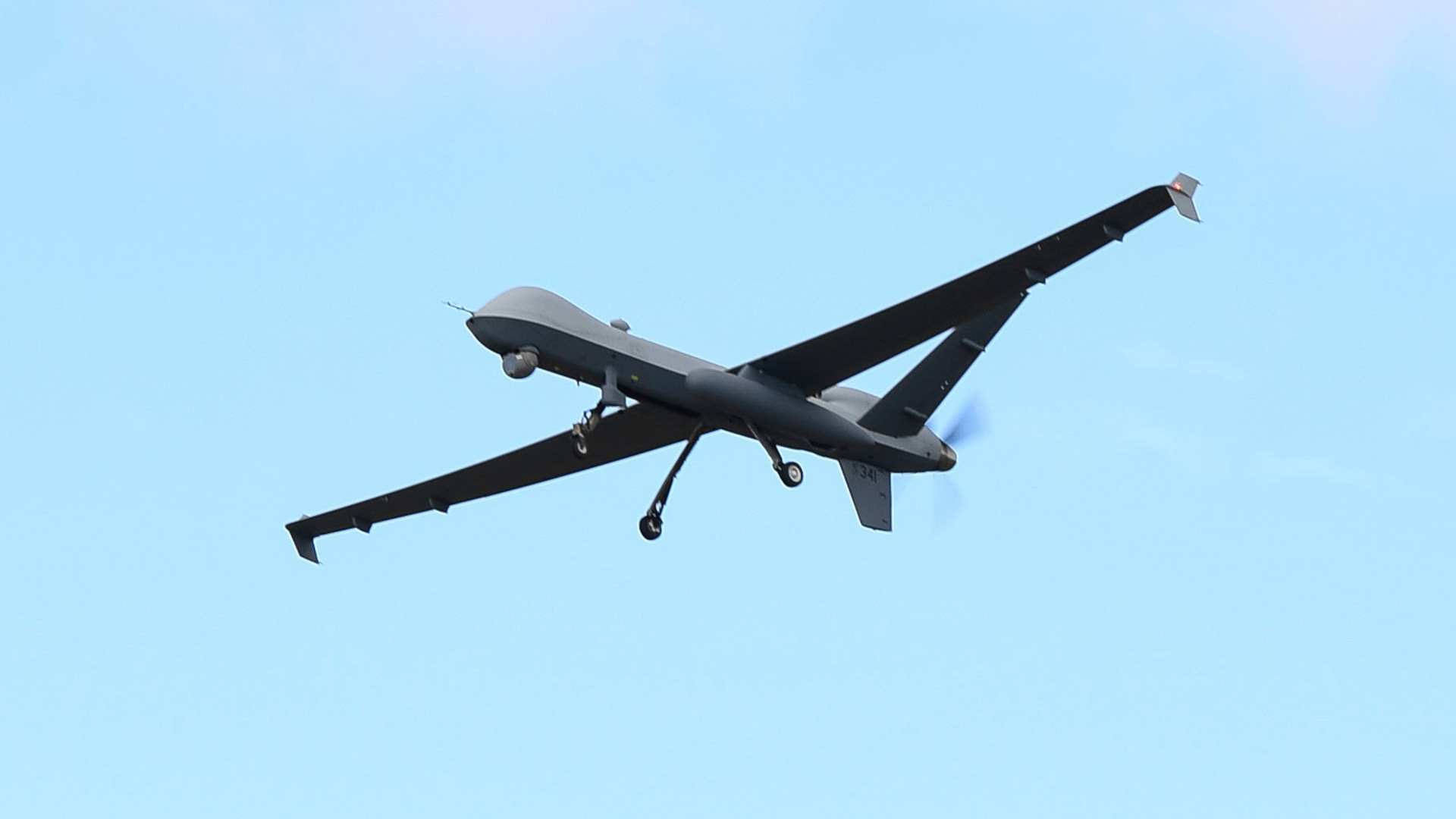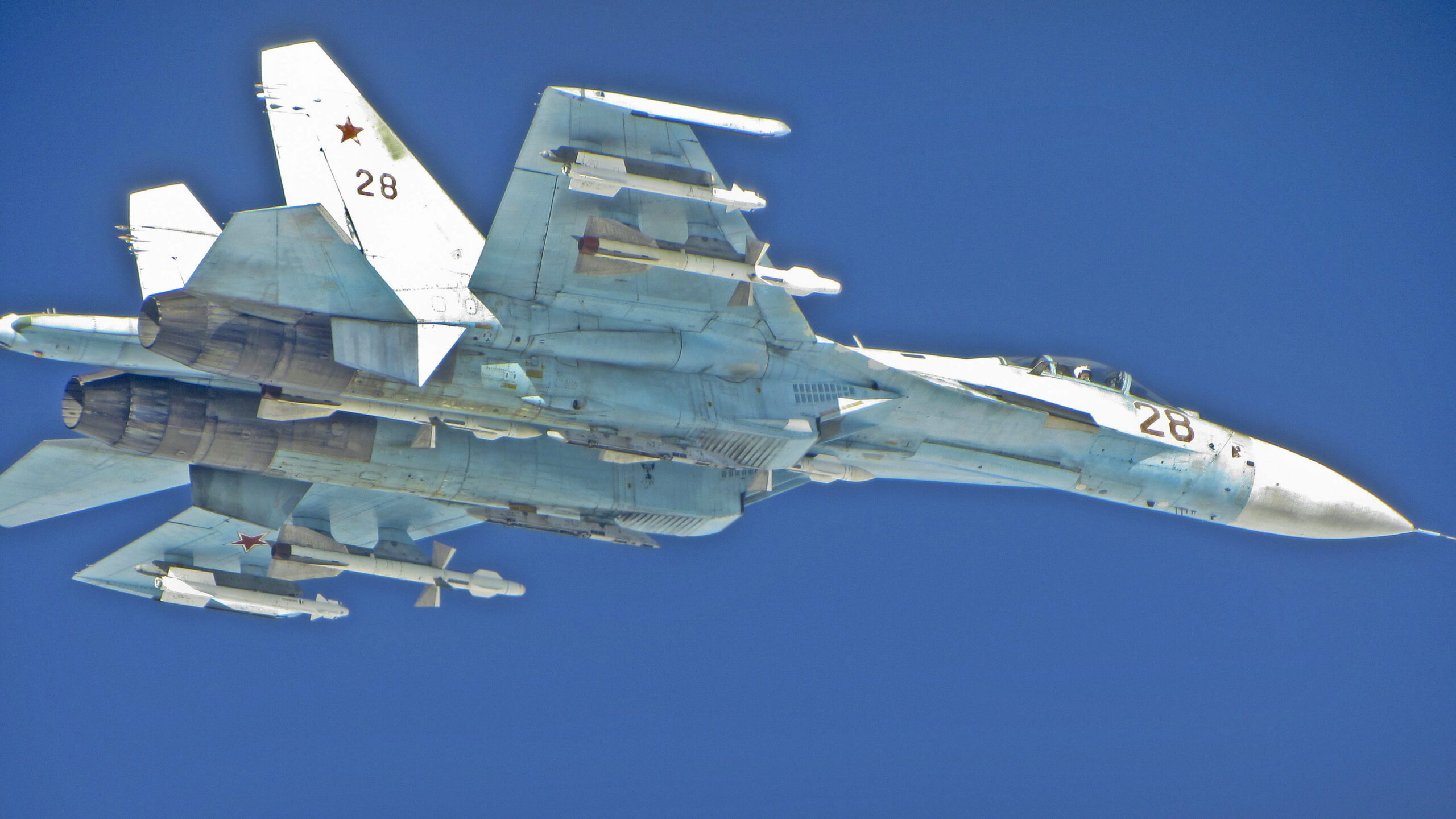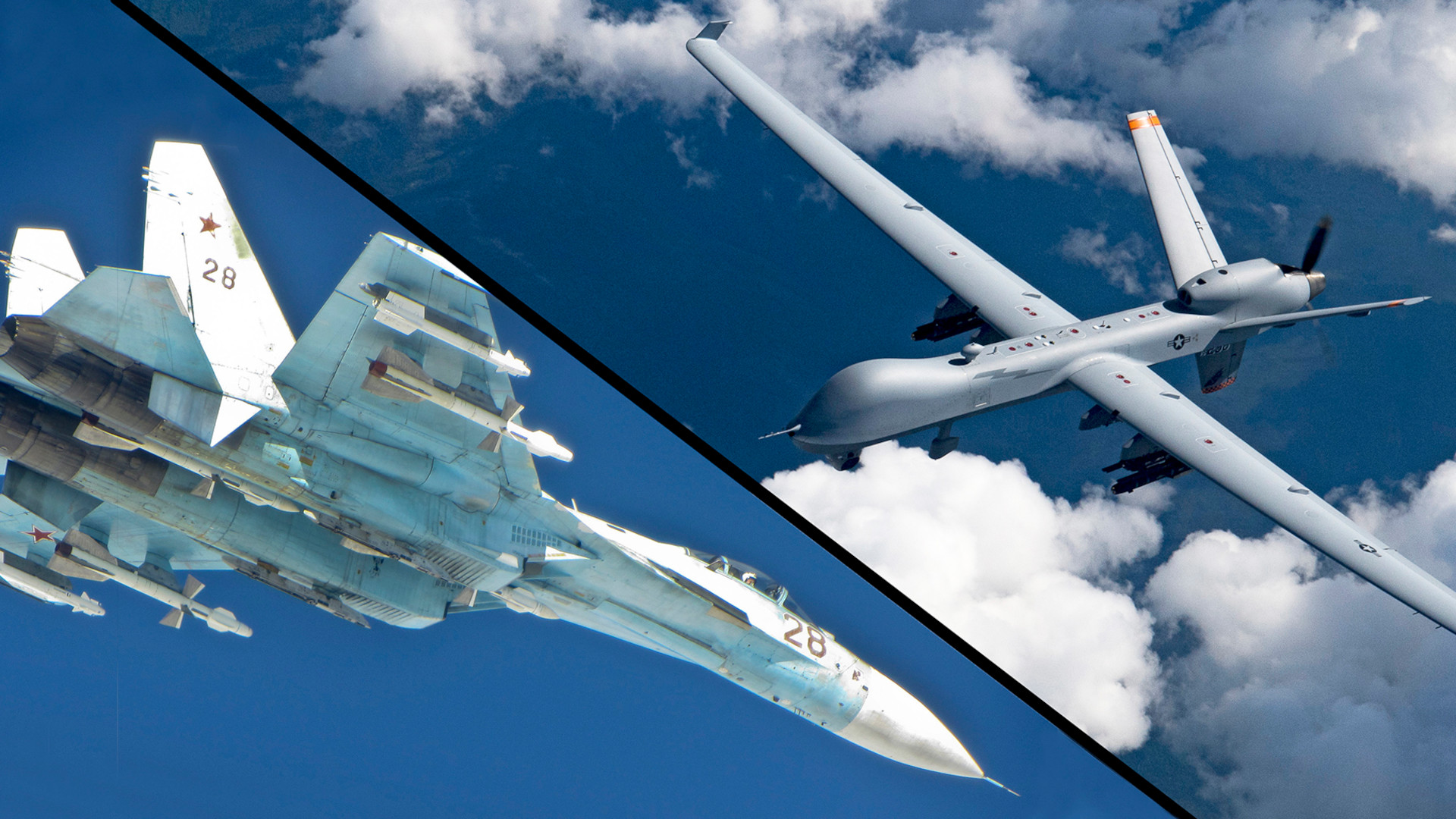The U.S. Air Force says that one of its MQ-9 Reaper drones crashed into the Black Sea today after a collision with a Russian Su-27 Flanker fighter jet. The incident was the end result of a “reckless” and “unprofessional” intercept of the uncrewed aircraft by a pair of Russian Su-27s in international airspace, according to the service.
The collision occurred at approximately 7:03 A.M. local time, according to a press release from U.S. Europe Command (EUCOM). News about the incident had already begun to emerge with reports saying officials were working to determine whether or not the drone was shot down. The USAFE statement makes clear that this was not the case.
“The Russian Su-27 aircraft struck the propeller of the MQ-9, causing U.S. forces to have to bring the MQ-9 down in international waters,” the press release explains. “Several times before the collision, the Su-27s dumped fuel on and flew in front of the MQ-9 in a reckless, environmentally unsound, and unprofessional manner.”

Though the exact motives of the Russian pilot are unclear, U.S. officials do not see any clear indications one way or another that there was a deliberate intention to bring down the drone. “There was [a] deliberate intent to interfere with the MQ-9, but the collision seems to be simple incompetence,” an Air Force official separately told The War Zone.

It’s unclear where the MQ-9 was operating from or what it unit it was assigned to. The Air Force does have Reapers based in Romania on the Black Sea, as well as elsewhere in Europe, such as Naval Air Station Sigonella in Italy. Reapers were conducting routine intelligence, surveillance, and reconnaissance (ISR) operations in the region long before Russia launched its all-out invasion of Ukraine in February 2022. One of those drones, assigned to the 31st Expeditionary Operations Group, Detachment One, crashed in that country in July 2022 for still unclear reasons.

The condition of the Russian Su-27 following today’s collision is unclear.
“Immediately after the impact, the video footage cut out for several seconds. It is unclear what damage the Su-27 incurred, but it returned to base,” an Air Force official has told The War Zone, adding that they did not know which base the Russian aircraft had come from or returned to. “I’m sure the impact left a mark, though. A few inches further forward, and the Russian jet would have been severely damaged and probably destroyed.”
There are now unconfirmed reports of a Russian Su-27 landing at a base in Crimea with some degree of damage. The base in question is very likely Belbek, home to the 38th Fighter Aviation Regiment, which flies Su-27SM Flankers.
It is also not clear what other actions U.S. forces may have taken, including whether or not there were any attempts to contact any level of the Russian military during or after the incident. “We have not talked to the Russians directly from USAFE,” an Air Force official also told The War Zone, but they could not say whether other U.S. authorities did.
At a routine press conference that came after the incident over the Black Sea today, State Department spokesperson Ned Price said that the U.S. government has engaged with allies and partners to inform them about the situation. American officials are engaging with the Russians, including with the country’s Ministry of Foreign Affairs, and they plan to summon the country’s ambassador in Washington to convey their strong objections directly to the Kremlin, according to Price.
The War Zone has reached out to the Office of the Secretary of Defense, the White House’s National Security Council, the State Department, and NATO for more information.
“Our MQ-9 aircraft was conducting routine operations in international airspace when it was intercepted and hit by a Russian aircraft, resulting in a crash and complete loss of the MQ-9,” U.S. Air Force Gen. James Hecker said in a statement accompanying the press release. “In fact, this unsafe and unprofessional act by the Russians nearly caused both aircraft to crash.”
Hecker is head of US Air Forces in Europe, the Air Force’s top command in the region, as well as Air Forces Africa (AFAFRICA) and NATO’s Allied Air Command. The Air Force, among others, routinely conducts ISR operations over and around the Black Sea using crewed and uncrewed aircraft.
“U.S. and Allied aircraft will continue to operate in international airspace and we call on the Russians to conduct themselves professionally and safely,” he continued.
“This incident demonstrates a lack of competence in addition to being unsafe and unprofessional,” the press release added. “This incident follows a pattern of dangerous actions by Russian pilots while interacting with U.S. and Allied aircraft over international airspace, including over the Black Sea. These aggressive actions by Russian aircrew are dangerous and could lead to miscalculation and unintended escalation.”
USAFE did not highlight any particular incidents, but such interactions between Russian and U.S. aircraft, as well as Russia’s planes and those belonging to other NATO members, over the Black Sea, and elsewhere, are hardly new.


The U.K. Ministry of Defense did previously say that a Russian Su-27 Flanker had “released” a missile during an intercept of Royal Air Force (RAF) RC-135W Rivet Joint electronic surveillance aircraft in October 2022. Though it remains unclear whether the Flanker actually fired a missile at the British Rivet Joint, this pointed to a point escalation in Russian tactics and otherwise highlighted the risks of dangerous miscalculation during incidents like this. It prompted the RAF to send Typhoon fighter jets to escort RC-135Ws on at least some subsequent missions in the region.
It is, of course, worth noting that even shooting down uncrewed platforms inherently presents lower risks of escalation due to the fact there is no one on board who could be injured or die. This reality was underscored by the Iranian shootdown of a U.S. Navy RQ-4N Broad Area Maritime Surveillance-Demonstrator (BAMS-D) drone over the Gulf of Oman in 2019. That incident, which ultimately did not provoke direct overt retaliation from the U.S. military, followed years of other aggressive Iranian intercepts of U.S. drones. American fighter jets have been dispatched, at least on some occasions in the past, to ward off Iran’s aircraft.
The Black Sea, already, is a constrained environment, both for aircraft and ships, which presents its own inherent risks during peacetime and war.
Today’s incident does, of course, come amid long-standing concerns about the potential for the conflict in Ukraine to spill out more broadly in the region. Russian officials, including President Vladimir Putin, routinely issue nebulous threats to retaliate against the United States, other members of NATO, and other countries over military aid and other support for Ukraine. How either side will react to the loss of the MQ-9 remains to be seen.
We will continue to update this story as more information becomes available.
UPDATE 3:40 PM EST:
The Russian Ministry of Defense has now issued a statement claiming that there was no collision and that the U.S. Air Force MQ-9 maneuvered sharply before apparently entering uncontrolled flight and falling into the Black Sea. The Ministry also said the Reaper was flying without transponders on and had flown into airspace that Russian authorities declared as restricted after launching the all-out invasion of Ukraine last year.
The Russian Ministry of Defense has so far provided no evidence to substantiate any of these claims.
Multiple sources familiar with Reaper operations and performance noted that changes in power can result in rapid deceleration. With the Su-27 and MQ-9 being about as dissimilar as possible from one another, it’s possible a Russian aircraft looking to harass the MQ-9 could have rammed into it during a minute power change. Also, MQ-9 pilots have very limited situational awareness around them, which only increases the risks of an intercepting aircraft flying much too close.
At a routine press briefing today, Pentagon Press Secretary U.S. Air Force Brig. Gen. Patrick Ryder said that efforts were being made to declassify imagery captured by the MQ-9 during the incident. If such imagery is released, this could help shed more light on exactly what transpired.
Ryder also said that he had nothing to share on potential U.S. efforts to recover the drone and that he was not aware of any Russian attempts so far to do so, either. Russia’s military and intelligence services certainly have experience in and specialized capabilities for recovering objects from the bottom of large bodies of water. This would add to the potential imperative for the U.S. military to do so first, especially given that the MQ-9 could have been carrying sensitive sensors and other systems during this mission.
The War Zone has reached out to the Navy for more information on what steps may already be being taken to recover the MQ-9.
UPDATE 8:20 PM EST:
A question that has come up around this incident is why can’t drones like the MQ-9 be armed for self-defense? The answer is that they actually can be, as you can read about more in this separate War Zone piece.
Contact the author: joe@thedrive.com
